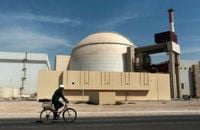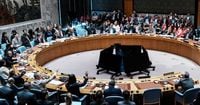In a dramatic escalation of diplomatic tensions, Iran, Russia, and China have jointly declared to the United Nations that the 2015 nuclear agreement with Tehran, known as the Joint Comprehensive Plan of Action (JCPOA), is now formally terminated. This move, communicated in a joint letter to the UN on October 18, 2025, marks the end of the Security Council’s consideration of Iran’s nuclear program and sets the stage for a contentious new chapter in international relations.
The joint letter, delivered to UN Secretary-General António Guterres and the Security Council, asserts that all provisions of UN Security Council Resolution 2231—the framework endorsing the nuclear deal—have reached their predetermined conclusion, as outlined in operative paragraph 8 of the resolution. According to Iran’s Foreign Ministry, the 10-year period defined by Resolution 2231, adopted on July 20, 2015, officially expired on October 18, 2025, terminating all restrictions and mechanisms related to Iran’s nuclear activities from that date.
Iran’s Foreign Minister Abbas Araghchi, in a separate letter to the UN, was unequivocal: “After Oct. 18, all provisions of the Resolution 2231 and the preceding sanctions resolutions should automatically terminate with no continuing legal effect.” As reported by The Media Line, Araghchi’s correspondence emphasized that, from Tehran’s perspective, all UN Security Council resolutions and restrictions tied to Iran’s nuclear program have no continuing legal force as of October 18.
The joint notification from Iran, Russia, and China was a direct response to the so-called “snapback” mechanism triggered by France, the United Kingdom, and Germany—collectively known as the E3—on August 28, 2025. The E3’s action sought to reimpose UN sanctions on Tehran, including an arms embargo, missile activity limits, asset freezes, financial restrictions, and prohibitions on uranium enrichment and reprocessing. The European powers justified their move by citing what they called Iran’s “clear and deliberate” non-compliance with the 2015 deal, arguing that Tehran’s stockpile of highly enriched uranium has “no civilian justification” and poses a “clear threat to international peace and security,” as reported by Agence France-Presse (AFP).
Yet Iran, with the backing of Russia and China, has fiercely contested the legitimacy of the snapback. The joint letter to the UN characterized the E3’s attempt as “legally and procedurally flawed,” arguing that the European parties “lack the standing to invoke its provisions” since they themselves had ceased to fulfill their commitments under both the JCPOA and Resolution 2231. Moscow and Beijing echoed this view, with Iran’s Foreign Ministry spokesman Esmail Baghaei stating, “Moscow and Beijing both made clear that the European powers lacked the legal standing to use the mechanism, since they had already violated the JCPOA.”
Baghaei further insisted that the expiration of Resolution 2231 means all previously imposed restrictions are now void, and Iran’s nuclear rights—including uranium enrichment and research—remain intact. “The rights gained under this resolution, such as enrichment and the expansion of peaceful nuclear activities, continue to stand,” he said at a press briefing, as reported by Kurdistan24. Baghaei also accused the United States of violating international law by unilaterally withdrawing from the agreement in 2018 and criticized European governments for failing to meet their obligations.
Iran’s letter to the UN, released by the official Islamic Republic News Agency (IRNA), went even further in its legal assertions. Foreign Minister Araghchi declared, “Any claim of ‘revival’ or ‘restoration’ of terminated resolutions is null and void, lacks legal basis, and is incapable of creating a binding effect.” He argued that the E3’s snapback effort was “procedurally flawed and substantively invalid,” and that any attempt to reimpose sanctions is “null and void, lacks legal basis, and is incapable of creating a binding effect.”
The dispute over the snapback mechanism is not merely a matter of legal interpretation, but a reflection of the broader collapse of the JCPOA. Iran’s letter placed the blame squarely on the United States and its European allies, recounting the U.S. withdrawal from the deal on May 8, 2018, and the subsequent reinstatement of “illegal, unilateral, and extraterritorial sanctions.” The letter also accused the E3 of a “material breach” of the JCPOA, stating, “The European parties to the JCPOA, namely France, Germany, and the United Kingdom, despite their initial commitment to preserving the agreement and compensating for the effects of the US withdrawal, not only failed to fulfill their commitments, but also imposed additional illegal sanctions against Iranian individuals and entities.”
Iran maintains that it exercised “utmost restraint” for a year after the U.S. withdrawal before beginning its own “phased, proportionate, and reversible remedial measures” in May 2019, which included incrementally breaching the deal’s limits on enrichment and stockpiles. Tehran also accused the U.S. and Israel of sabotage and aggression against its nuclear facilities, specifically referencing the June 2025 strikes that reportedly destroyed or disabled all of Iran’s nearly 22,000 centrifuges.
The European powers, for their part, remain adamant that Iran’s actions have left them no choice. Their August 28, 2025, joint statement asserted that Iran’s non-compliance “remains a clear threat to international peace and security.” The United States welcomed the E3’s move, with Secretary of State Marco Rubio pledging to support the full implementation of the snapback sanctions.
Amid this diplomatic and legal standoff, Iran is not standing still. Satellite imagery reviewed by The Washington Post has revealed increased activity at a fortified underground complex known as “Pickaxe Mountain,” near the damaged Natanz nuclear facility. Experts speculate that the site could be intended as a new, covert uranium enrichment facility, potentially beyond the reach of both airstrikes and international inspectors. The fate of Iran’s pre-strike stockpile of nearly 900 pounds of uranium enriched to 60 percent purity—a technical step away from weapons-grade—remains unclear, further complicating the standoff.
Meanwhile, the economic consequences for ordinary Iranians are severe. As cited by Kurdistan24, the country faces a record-low currency and skyrocketing prices for essential goods, with human rights groups reporting a surge in executions amid a harsh domestic crackdown.
For now, the fate of UN sanctions and Iran’s nuclear program hangs in the balance. The joint position of Iran, Russia, and China signals a deepening rift with the West and a potential realignment in international diplomacy. As the world watches, the question remains: will the legal and diplomatic arguments prevail, or will the dispute spiral into further confrontation?

